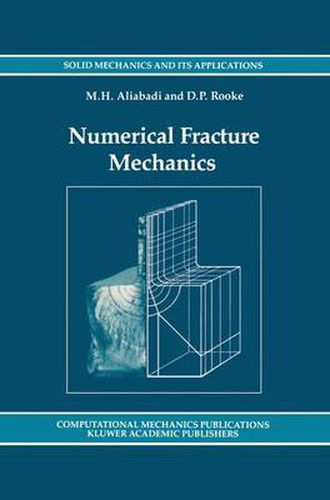Readings Newsletter
Become a Readings Member to make your shopping experience even easier.
Sign in or sign up for free!
You’re not far away from qualifying for FREE standard shipping within Australia
You’ve qualified for FREE standard shipping within Australia
The cart is loading…






This title is printed to order. This book may have been self-published. If so, we cannot guarantee the quality of the content. In the main most books will have gone through the editing process however some may not. We therefore suggest that you be aware of this before ordering this book. If in doubt check either the author or publisher’s details as we are unable to accept any returns unless they are faulty. Please contact us if you have any questions.
The purpose of this book is to present, describe and demonstrate the use of numerical methods in solving crack problems in fracture mechanics. The text concentrates, to a large extent, on the application of the Boundary Element Method (BEM) to fracture mechanics, although an up-to-date account of recent advances in other numerical methods such as the Finite Element Method is also presented. The book is an integrated presentation of modem numerical fracture mechanics, it contains a compilation of the work of many researchers as well as accounting for some of authors’ most recent work on the subject. It is hoped that this book will bridge the gap that exists between specialist books on theoretical fracture mechanics on one hand, and texts on numerical methods on the other. Although most of the methods presented are the latest developments in the field of numerical fracture mechanics, the authors have also included some simple techniques which are essential for understanding the physical principles that govern crack problems in general. Different numerical techniques are described in detail and where possible simple examples are included, as well as test results for more complicated problems. The book consists of six chapters. The first chapter initially describes the historical development of theoretical fracture mechanics, before proceeding to present the basic concepts such as energy balance, stress intensity factors, residual strength and fatigue crack growth as well as briefly describing the importance of stress intensity factors in corrosion and residual stress cracking.
$9.00 standard shipping within Australia
FREE standard shipping within Australia for orders over $100.00
Express & International shipping calculated at checkout
Stock availability can be subject to change without notice. We recommend calling the shop or contacting our online team to check availability of low stock items. Please see our Shopping Online page for more details.
This title is printed to order. This book may have been self-published. If so, we cannot guarantee the quality of the content. In the main most books will have gone through the editing process however some may not. We therefore suggest that you be aware of this before ordering this book. If in doubt check either the author or publisher’s details as we are unable to accept any returns unless they are faulty. Please contact us if you have any questions.
The purpose of this book is to present, describe and demonstrate the use of numerical methods in solving crack problems in fracture mechanics. The text concentrates, to a large extent, on the application of the Boundary Element Method (BEM) to fracture mechanics, although an up-to-date account of recent advances in other numerical methods such as the Finite Element Method is also presented. The book is an integrated presentation of modem numerical fracture mechanics, it contains a compilation of the work of many researchers as well as accounting for some of authors’ most recent work on the subject. It is hoped that this book will bridge the gap that exists between specialist books on theoretical fracture mechanics on one hand, and texts on numerical methods on the other. Although most of the methods presented are the latest developments in the field of numerical fracture mechanics, the authors have also included some simple techniques which are essential for understanding the physical principles that govern crack problems in general. Different numerical techniques are described in detail and where possible simple examples are included, as well as test results for more complicated problems. The book consists of six chapters. The first chapter initially describes the historical development of theoretical fracture mechanics, before proceeding to present the basic concepts such as energy balance, stress intensity factors, residual strength and fatigue crack growth as well as briefly describing the importance of stress intensity factors in corrosion and residual stress cracking.